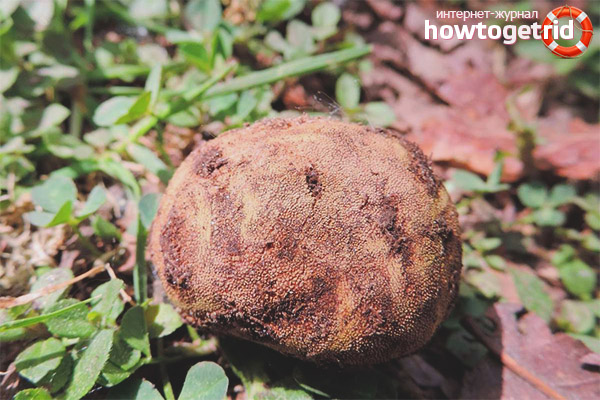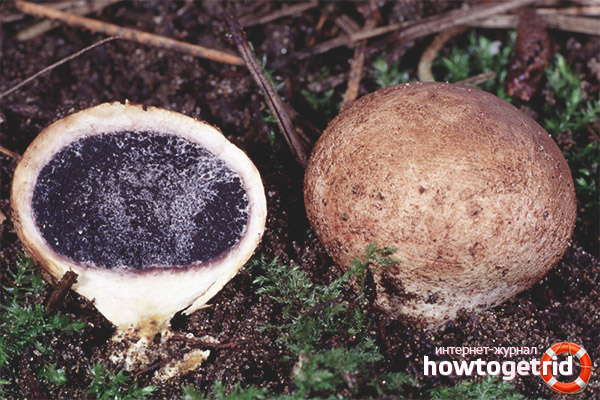The content of the article
All truffles are appreciated by gourmets because they are rare and quite tasty. But in today's article, we will study an inedible representative belonging to the family of Elafomycetes and the genus of Elaphomyces. We are talking about deer truffle - a fruiting body of a small size, which is also called rain or grainy. People do not consume these mushrooms as food, but representatives of the animal world really like them. Squirrels, deer and hares lie on truffles, a real battle for fruiting bodies can begin.
Description
- Like the rest of this family, truffles grow directly in the soil. They are small, in diameter grow to a maximum of 5 cm, but in reality there are much fewer specimens. By weight reach 18 g. everyone.
- In the process of heat treatment (drying), the form practically does not change. It remains round or tuberous. In external characteristics, these fruiting bodies resemble walnuts or hazelnuts. It feels quite compacted.
- The fruiting body itself is covered with a crust with tubercles and the likeness of warts. The thickness of this bark is about 3 mm. The color of the mushrooms is light yellow, brown with rusty spots, brown-red, brown-golden. In early spring, sometimes quite bright specimens of a red tone are found.
- This representative has no reason. The soft part is hard, painted radially, includes several layers. The edges are orange, thin, followed by a whitish color, then thicker gray-brown blotches. The composition of the pulp ends with a thin white layer, and in the center of the fungus is black-gray.
- In some cases, the central part may be whitish, stained with a dark gray tone. The soft part is bitter, the aroma is practically absent, in some cases it is simply unpleasant.
- In young animals, the soft part is painted in a light marble tone. She is reddish, with light specks. Mature fruiting bodies take on a purple or brownish-purple hue, and dust forms. This powder is a spore that is colored either black or brown-black.
Growth
- Often, fruit specimens can be found in forest strips in which pine trees grow. They can also live with fir trees. Find fruiting bodies in larch, squares, park areas. Sand is considered a favorite soil for growth.
- Mushrooms are not directly underground; they prefer to settle closer to the surface of the soil. They live at shallow depths, for example, under a bed of leaves, moss or needles.
- Find fruiting bodies will be at a depth of 2 to 15 cm, but the average figure is 5 cm. Mushrooms are located in the root system of trees. This is how mycorrhiza is built. Species of trees suitable for these purposes can be very different.
Doubles
- The external characteristics of this fruiting body have certain similarities. A close relative of the fungus under discussion is the prickly truffle. It has a shell pigmented with a brownish-yellow hue. Truffles grow in birch groves or next to single trees of this breed.
- Also, the variety of fruit bodies under discussion has another double, which is called nothing more than a red-brown truffle. It is a small tuber or bunch, which grows up to 7 cm in diameter. The surface is brown-red or brown-pink. The soft part smells good, it looks like a brain.
- Deer specimen refers to marsupial fruit bodies that live underground. It is not like a real delicacy, it was often used by fraudsters who gave out this fruiting body under the guise of a delicacy.The genus includes about twenty species. Some species grow in the coniferous strip, others in the larches of European countries.
Edibility
- It has already been mentioned that mushrooms are not eaten. However, these instances are considered a real treat for some inhabitants of the animal world. We are talking about squirrels, mice, badgers, wild boars, deer, etc.
- If the year was not fruitful, squirrels begin to dig the earth in order to find these fruiting bodies. They dig the soil to a depth of 8 cm. When you really want to eat, they look for truffles in the snow.
In today's article, we examined everything that affects a representative of the Elaphomycete family. We are talking about deer truffle, which is not consumed by humans for food. This fruiting body serves as a snack for forest inhabitants, which is often used by hunters. They attract squirrels and wild boars to such specimens.











Submit